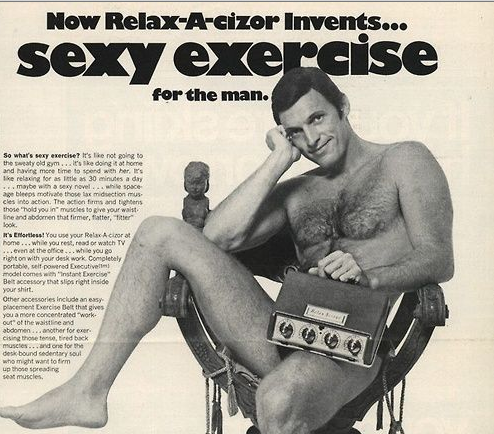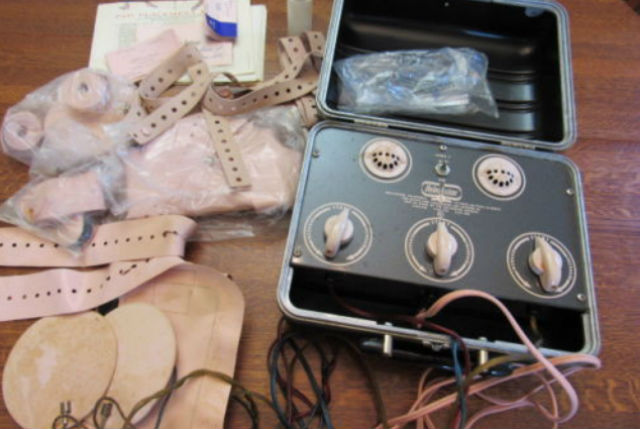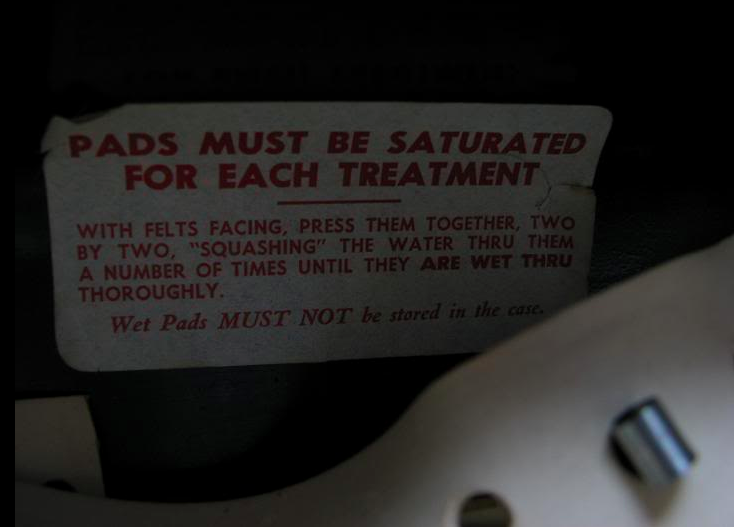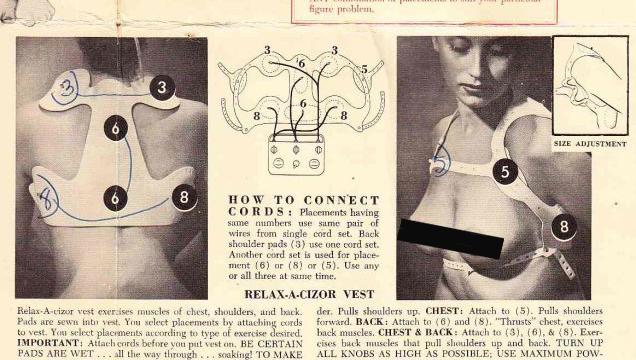One of the first-ever fitness wearable was so dangerous it was banned by the US government for causing miscarriages and hernias. The line between “convenient exercise device” and “ornate torture tool” was thinner back in the 1950s.
Before it was outed as medically horrifying, the Relax-A-Cizor was marketed as an easy way to get thin in your sleep, a glamorous “reduction” contraption endorsed by Doris Day.
Invented by an engineer named William J. Browner, who hand-built and sold prototypes around Hollywood after World War II, the Relax-A-Cizor was a hit throughout the 1950s and 1960s, selling over 400,000 devices at $US100 to $US400 a pop before people figured out it was a claptrap paralysis-causing hazard.

In 1952, the New Yorker praised it as the “first portable reducing machine in the world,” and interviewed a Relax-A-Cizor “contour consultant” who insisted it would make callisthenics obsolete. Selling “sexy exercise” worked.
To use the device, people placed electrode pads — two to 12, depending on their model — on their “problem areas”. They turned the machine on for 30 to 60 minutes, or 10 minutes for the face. Attaching more than one pad to the body created a complete electrical circuit, and people could control the intensity of the electric pulses with a dial as its “slimming” jolts stimulated muscles via motor nerves, all while they lay around in ultimate lazy comfort, blissfully unaware of its high chances for inducing catastrophic malady.
With its emphasis on effort-free fitness, the Relax-A-Cizor an ancestor of those ab belts you’ll see on late night infomercials.
Modern ab belts are scammy, but the Relax-A-Cizor was in a different league, a version so flagrantly irresponsible that the Food and Drug Administration eventually recommended that people destroy existing units to prevent people from getting paralysed or losing consciousness.

Vintage Relax-A-Cizor for sale on Ebay.
Before it was banned, people started complaining of an impressively wide array of injuries caused by the Relax-A-Cizor. Eventually some of those people helped bring the company down. A Chicago Tribune article from 1970 recounts some of the gruesome consumer testimony that led to an FDA lawsuit against the company, Relaxacizor:
A young woman noticed fibrillation [very rapid irregular muscle contractions] of the heart. Another young woman reported she had suffered a miscarriage after placing the pads across her abdomen.
Judge William Grey, who banned the device, damned the machine as capable of causing a diverse horror-roster of health problems, like ruptured blood vessels, hernias, cramps, vomiting, urinary discharge, anxiety, skin rashes, paralysis, numbness, nervousness, difficulty swallowing, miscarriage and loss of consciousness. The judge also acknowledged that the device could worsen pre-existing conditions like epilepsy.
The Relax-A-Cizor trades in the same weight loss myth that ab belts do: The idea that you can “exercise” without trying by wearing a device that does all the hard work for you. There is some evidence that electric stimulations from belts like these can change muscle tone, but the minimal muscle improvements aren’t big enough to give people visibly ripped abs or change the scale. For that reason, the Federal Trade Administration has ordered ab belt makers to give money back to customers for making unsubstantiated claims about weight loss.
The problem with the Relax-A-Cizor wasn’t that it was wholly ineffective: The device did make muscles contract, at a rate of 40 contractions a minute, according to United States v. Relaxacizor, the lawsuit filed by the FDA in 1970. It was that the contractions were more likely to make you ill than svelte.
Consider the design: Relax-A-Cizor manuals include directions like “PADS MUST BE SATURATED FOR EACH TREATMENT.” Insisting that people get the pads they’re about to use to send electricity coursing through their bodies soaking wet is a bold move.

“Squashing”.
These contractions were nothing like what happens to your muscles when you do crunches or push-ups or otherwise work out like a regular human, as the lawsuit points out:
The involuntary muscle contractions caused by Relaxacizor are abnormal and cannot be equated with ordinary exercise. The Relaxacizor actuates small groups of muscles without body mechanisms that normally protect against stress. There may be a lack of the usual warning signs of fatigue and pain which signal the need to stop. The damage caused by Relaxacizor may occur before the warning of pain or fatigue.
So not only was Relax-A-Cizor primed to injure people, it was primed to injure people before they realised something was amiss with the powerful tangle of shock-pads they’d strapped on.

Relax-A-Cizor instruction manual.
The judge’s accusations about what the Relax-A-Cizor does to people with cancer are intense:
Portions of malignant tumours may flake off and enter the lymphatic system or bloodstream due to the trauma which Relaxacizor produces. Cancer cells that are otherwise dormant may be activated and spread by the sudden, violent, rapid, repetitive, and unnatural movements of internal organs and skin surfaces caused by the Relaxacizor.
Wait, what?
The Relax-A-Cizor was ineffective and sketchy, but the accusation that the Relax-A-Cizor can straight-up activate cancer makes me wonder what the hell the judge was basing his assessment from. I emailed electrical injury expert Dr Michael Morse about the claim. “I am at a loss on this one,” he wrote.
FDA historian Dr John Swann noted that the FDA moved against the Relax-A-Cizor after doing a study at Duke University that confirmed how harmful it was, so I don’t know what kind of wacky cancer activation tests they had going on over there. Unfortunately, the legal decision against Relax-A-Cizor doesn’t include the raw results of that study.
The Relax-A-Cizor came back into the public eye in an early episode of Mad Men, when new copywriter Peggy Olsen has to come up with an ad campaign for the device (albeit a fictionalised version that looks like a brutal pair of plastic granny panties for depressed hags). She discovers that the “reducing” device doubles as an old-timey masturbation machine, since the buzzing electricity can work as a kind of diaper-vibrator.
That Mad Men episode jogged nostalgia and renewed interest in the Relax-A-Cizor, and it was the perfect contraption to feature on such a symbol-obsessed show. Relax-A-Cizor debuted at the perfect generational moment, when convenience and modernity were hallowed as escape-traps from the drudgery of life. Why exercise when you could let a machine do it for you?

I couldn’t find any real-life anecdotes of using the buzzing electrode pads as a clandestine sex toy, but that doesn’t mean it never happened.
If the description and history doesn’t scare you, or you’re curating a private collection of medical horrors, you can buy a vintage Relax-A-Cizor on Ebay and Etsy. It’s still illegal to resell them, but the sellers don’t seem to care.
Screenshots: Ebay and Twitter
